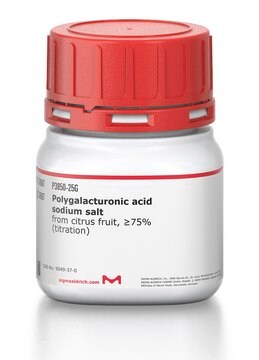P9416
TWEEN® 20
for molecular biology, viscous liquid
Sinónimos:
Monolaurato de sorbitán polietilenglicol, Monolaurato de sorbitán polioxietileno
About This Item
Productos recomendados
biological source
corn
plant (Palm)
plant (coconut)
wheat
Quality Level
grade
for molecular biology
description
non-ionic
assay
>40% (GC)
form
viscous liquid
mol wt
~1228
~1228
composition
lauric acid, ≥40% (balance primarily myristic, palmitic, and stearic acids)
concentration
≥40.0% (GC)
impurities
RNAse, none detected
endonuclease, none detected
exonuclease, none detected
refractive index
n20/D 1.468 (lit.)
CMC
60 mg/L
solubility
water: 100 mg/mL, clear, colorless to yellow
density
1.095 g/mL at 25 °C (lit.)
suitability
suitable for molecular biology
foreign activity
Endonuclease-exonuclease and RNase, none detected
SMILES string
CCCCCCCCCCCC(=O)OCCOCC(C1C(C(CO1)OCCO)OCCO)OCCO
InChI
1S/C26H50O10/c1-2-3-4-5-6-7-8-9-10-11-24(30)34-19-18-31-20-22(32-15-12-27)26-25(35-17-14-29)23(21-36-26)33-16-13-28/h22-23,25-29H,2-21H2,1H3
InChI key
HMFKFHLTUCJZJO-UHFFFAOYSA-N
¿Está buscando productos similares? Visita Guía de comparación de productos
General description
Surfactants, possessing both hydrophilic and hydrophobic components, fall into two main categories: ionic, which ionize in water (anionic, cationic, or ampholytic), and nonionic, which do not ionize. The discussed product is a nonionic surfactant with diverse applications such as emulsification, dispersion, solubilization, and detergent use. Additionally, it can serve as a solubilizer for membrane proteins.
Application
- As an emulsifying agent for the preparation of stable oil-in-water emulsions
- In pre-extraction of membranes to remove peripheral proteins (used at 2% for extraction of membrane-bound proteins)
- As a blocking agent for membrane based immunoassays at a typical concentration of 0.05%
- For lysing mammalian cells at a concentration of 0.005 to 0.5%
- Along with PBS in the dilution of antibodies in immunohistochemistry technique
- For washing cells in FISH (Fluorescence in situ hybridization) technique
Features and Benefits
- Highly versatile surfactant for your Life Science and Biochemical research
- Suitable for sensitive molecular biology research applications
- Tested for Endonuclease, exonuclease and Rnase′s
- Excellent solubilising, dispersing and emulsifying agent
Caution
Preparation Note
Other Notes
Legal Information
Comparable product
Optional
Storage Class
10 - Combustible liquids
wgk_germany
WGK 1
flash_point_f
527.0 °F - Pensky-Martens closed cup
flash_point_c
275 °C - Pensky-Martens closed cup
ppe
Eyeshields, Gloves
Certificados de análisis (COA)
Busque Certificados de análisis (COA) introduciendo el número de lote del producto. Los números de lote se encuentran en la etiqueta del producto después de las palabras «Lot» o «Batch»
¿Ya tiene este producto?
Encuentre la documentación para los productos que ha comprado recientemente en la Biblioteca de documentos.
Los clientes también vieron
Protocolos
cAMP measurements are obtained using an ELISA assay (Harlow and Lane 1988). Commercial radio-immunoassays, or ELISA kits, to assay cAMP can be purchased from various manufacturers.
Membrane-based blotting applications that employ enzyme conjugates to generate colorimetric or chemiluminescent signal require the use of an added blocking step to decrease the signal generated by non-specific binding.
In Situ Hybridization of Whole-Mount Mouse Embryos with RNA Probes: Hybridization, Washes, and Histochemistry. This is a protocol describing how to perform in situ hybridization on whole mouse embryos. Here we describe the hybridization procedure, and the localization of the DIG-labeled RNA using a conjugate of anti-DIG Fab antibody and calf intestinal alkaline phosphatase. Enzyme activity of the reporter is detected by a color reaction, resulting in the formation of a water-insoluble purple/blue precipitate. Manipulating the Mouse Embryo - Third Edition
Contenido relacionado
Three-dimensional (3D) printing of biological tissue is rapidly becoming an integral part of tissue engineering.
Nuestro equipo de científicos tiene experiencia en todas las áreas de investigación: Ciencias de la vida, Ciencia de los materiales, Síntesis química, Cromatografía, Analítica y muchas otras.
Póngase en contacto con el Servicio técnico







